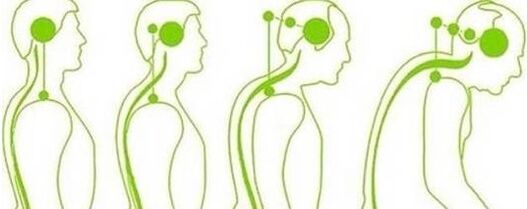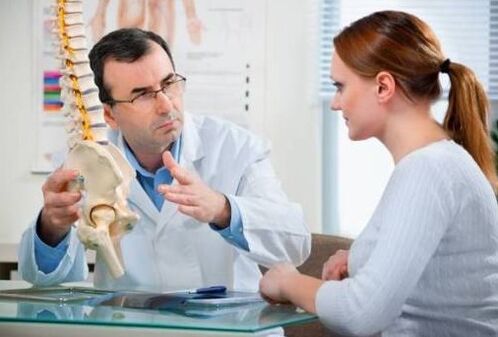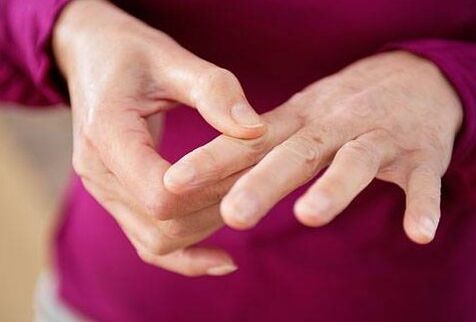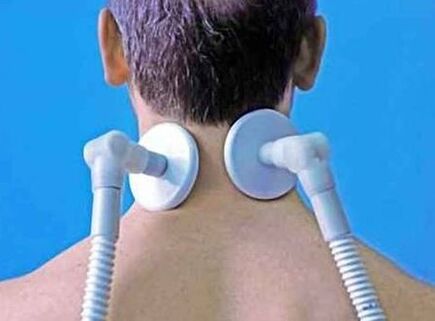The cervical osteocondrosis is developing in most adults, but can be a child due to certain conditions. When you see any signs that characterize such a disease, you should contact a therapist or narrow profile-neurologist.

Degenerative-dystrophic destruction of the cervical disk of the spine is characterized by cervical osteocondrosis. The progress of the disease leads to damage to intervertebral compounds, adjacent vertebres and ligamentous devices. Many others believe that osteocondrosis is the collapse of salts. However, such a statement is wrong. The salt can be really deposited due to various joints, but with other pathologies, such as gout development.
Thanks to the muscle system, the spine of a human tall consisting of seven vertebraes is caught. The muscles in this area have been poorly developed, so fatigue and spasms are formed for long-term tension. In the future, the mobility of cervical vertebraes is limited. As a result of this condition, the spinal discs are gradually destroyed, which provokes the beginning of the first stage of osteocondrosis. In the absence of treatment, the disease is constantly advancing, causing the lesions of all the waist. To prevent the development of complications, you need to pay attention to the first signs of pathology in a timely manner and take appropriate measures.
People such as most cervical osteoocondrosis face the lifestyle, at least people who provide for physical activity and sedentary work. The first features of such a person in such a person can show itself in the age of 25-30. The disease among children from the baby to adulthood is less common, but it can happen due to the wrong lifestyle or inherited factors.
The whole development process of osteocondrosis of cervical spine is divided into 4 main stages accompanied by certain symptoms. Treatment depends entirely on the established severity of the disease. For example, the first, preplinic stage does not require medicinal treatment. It is recommended to review the life style to improve the patient's condition - do physical exercises and eat properly. Characteristics of this stage: the rapid appearance of the muscles of all the backs of all the muscles, a little bit of tiredness, a bit of queues and trends of the head, but a material pain. In this case, the main shortcoming can be different from the fact that few people have the necessary importance to such symptoms, so it can not immediately apply to the hospital.

The following symptoms are characteristic of the second -DEGREE osteocondrosis:
- While moving the head, the pain gives more intense and periodically to the shoulders, hands, even low back;
- Pain syndrome may occur in a quiet position;
- have no occasional headaches;
- The attention is scattered, the level of work is reduced.
All of the above symptoms cannot continue to be out of regard, so looking for patient medical care at this stage of the disease. Strengthening pain is due to the disturbance of the distance between intervertebral disks and violations of nerves. The further complication of the situation occurs in the third stage. In this case, the pain in his neck is constantly worried, the muscles of the hands are very weak, from time to time the numbless occurs. When it comes to general symptoms, dizziness and weakness are becoming a patient's daily friends. Cervical spinal loses mobility.
The view of the neck, shoulders, arms, arms, ears, full signs of the open signs of a complete disabled and other diseases, show the beginning of the fourth stage of osteocondrosis. At the same time, intervertebral disks are destroyed and the pathological process is further moving forward along the spine affecting other departments. It is difficult to treat such a disease, the doctor may need surgery at the request. Thus, with the appearance of such symptoms: During the head movements, pain, dizziness, nausea, headaches, hands, as well as fatigue and coordinating problems should become an alarm indicating real health problems. Do not delay a visit to the doctor, a therapist or immediately to apply to a neuropathologist.
In the process of progressing cervical osteochondrosis, the spinal waist may occur. Different sensitive and motor disorders may appear depending on the affected spine:
- partial or complete loss of the sensitive of the oxipital region, in any part of the neck, shoulders and goals;
- Pain until neck, shoulders, forefront shrubs, hands, fingers;
- the numbness of the language where speech is broken;
- Decrease in muscle tone of the head and neck;
- Respiratory function, heart and pain in the liver.

Vertebra's exit edges can squeeze blood vessels into the brain. Thus, the blood circulation in the brain is broken and additional symptoms appear: in mood, insomnia, unreasonable concern, fear, irritation. At the same time, it can happen not a single headache with the spas of blood vessels, but also eye pain. Patients often celebrate the appearance of the "flies" in the eyes, sometimes fainting.
The most common cause of cervical osteocondrosis is considered a lifestyle with improper, unbalanced nutrition. Often lazy people suffer from nature, but also the profession, but also the same concern, the drivers and secrets of vehicles, so muscle spasms arise. The appearance of degenerative processes on the disks is related to metabolic processes and violations of the blood circulation. Other reasons for the development of cervical osteocondrosis are:
- Excessive weight with healthy nutrition;
- Revlatism, scoliosis, posture problems, straight legs;
- trauma of the spine and neck;
- regular stress, annoying overdraw;
- hereditary cause;
- The correct development of inborn cervical vertebrae.
It can be converted to a previous factor of sports, extreme intense physical activity, cervical osteocondrosis. In such circumstances, the main disease is the most disk. The latter, in intervertebral disks, mainly characterizes dystrophic disorders in lumbar and cervical discords. In this case, osteocondrosis is the result of a disk. In addition to the exclusion of severe physical strength, it is necessary with diagnosis, complex, medication and physiotherapeutic treatment.

The cervical region should be different between the consequences of osteocondrosis:
- Hernia and protrusions in the spine - may occur in the third and fourth stage due to the rapid progress of the main disease;
- The growth of bone tissues or the formation of osteophylls is the scrubbing those who often exit. Osteoofites have an irritating effect on muscles that increase their tones nearby. Thus, the pressure on intervertebral disks increases. In addition, educated osteophympits can cause arteries to narrow;
- The spinal disclosure - the reduction of intervertebral pit, causes the neck reduction between intervertebral disks, increases the risk of subluxation with the sharp return of cervical vertebrae;
- Sponge disk spontaneous or displacement does not occur as often as other complications, but in case of occurring, even death can cause even death. Any, the minimum change in the most likely probability of intervertebral disk is paralysis, more important displacement - for death.
Cervical osteochondrosis always leads to an increase in blood pressure. In addition, the main disease from one stage to another, contributes to the progress of hypertension to the first place because the pressure is more than 180 mm. Treatment directly helps hypertension reduce the severity of symptoms, but temporarily. If osteochondrosis is not treated, it is impossible to get rid of the growing blood pressure. In case of a disc damage between 4 and 5, as a complication, Periarthitis occurs. Characterizes the pinches of nerves located with a manual shoulder combination. At the same time, severe pain occurs on the shoulder of all the limbs of all limbs. In addition, osteocondrosis manifestations cannot be based on the symptoms of heart disease, such as the signs of the angina, but due to diagnostic measures, it is possible to distinguish diseases with high accuracy.
It is impossible to determine the osteoconondrosis of the cervical waist as a result of a palpation and visual medical examination. According to the date, the doctor can only assume that exactly is the reason for certain osteocondrosis. It is necessary to diagnose to confirm or refute such assumptions. The most optimal way today is MRI or magnetic resonance therapy. This method allows you to review all bone structures, the presence of intervertebral torns, osteophyte, and other complications of cervical osteocondrosis. Another, a little less informed way, the tomography is calculated. In addition, it allows you to determine the determination of the size of Hernia, because its presence can be difficult.

The treatment of osteocondrosis of the cervical region is always complicated and complex. Its term and saturation depends on the stage of development of the disease, the patient's individual characteristics and other, and the other is diseases. Often, in the second and later stages, it should be different between the main groups of frequent medications:
- Analgesics or painkillers. The funds on the list help to reduce temporary pain. With very pronounced pain, the NOVOCaine is used in the local blockade.
- Non-anti-inflammatory drugs and steroid anti -inflamic drugs. Non-level agents are safer, the analgesic effect and can be an alternative to ordinary analgesics. If they do not relieve pain, steroids are used.
- Antidepressants and Sedatives - Animeless, Valerian Tincture. Their goal is due to two factors: Osteocondrosis is a nervous overstrain or pain if it is so severe, if it has a negative impact on the psyche. The use of such drugs should be carried out during a serious observation, because each of the drugs is a number of contraindications and addiction.
- Mussors who help to eliminate muscle spasms. Analyzed effects with anti-inflammatory drugs.
- Vasransilators contributing to improving the blood circulation.
- Medications for integrity and normalization of metabolic processes are ideal for vitamins B and C.
The complex of these drugs is a symptomatic treatment. Compliance with the doctor's recommendations and passage of the scheduled course will help to eliminate pain and get rid of all the unpleasant manifestations of the disease. However, the therapeutic course does not end there. When the main features are eliminated, you can get the restoration of the cervical region to minimize the rest of the disease in the near future. Unfortunately, a large mistake of many people, after the disappearance of symptoms, is completely healthy and removing themselves. In this case, osteocondrosis, undoubtedly will remind him after a while.
The following physiotherapy procedures are used to treat cervical osteochondrosis:

- Medical physical education - only under the supervision of a qualified specialist, because the introductory exercises with serious lesions of intervertebral disks can cause more damage;
- Hand therapy - a hand effect in certain areas of the patient's body;
- therapeutic massage;
- Reflexology and variety, as acupuncture;
- Electrophorezz, balneotherapy, laser therapy, UFO, etc.
Each of the above procedures each has a number of opposite instructions, which is especially important for those who are not related to osteocondrosis of the cervical waist. The decision on the expediency of the use of a particular method remains with a doctor. It may not be safe to implement such measures of your own will. When it comes to traditional drug, you can use a saberfish, bran grass. Shape. It is also recommended to reduce salt intake. An approach to the treatment of cervical osteochondrosis will allow you to be sure of the disease. Allow this process to spend a long time, but complex therapy will reduce the chances of reconstruction to the minimum of the disease.

























